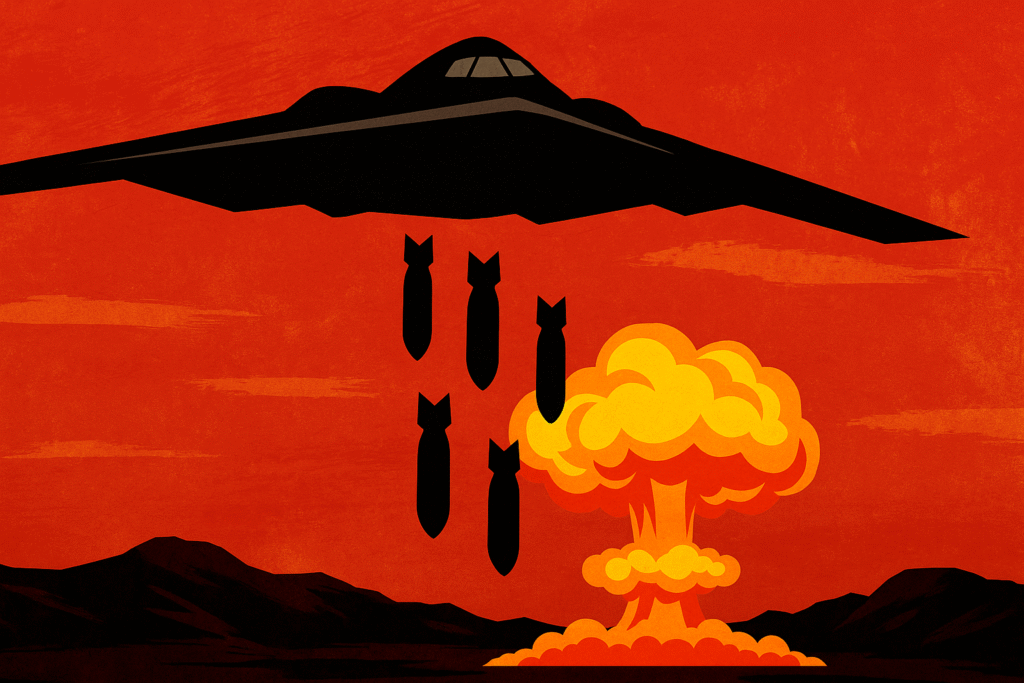The United States has officially entered the ongoing conflict between Israel and Iran, with President Donald Trump announcing that U.S. warplanes bombed three Iranian nuclear sites in a precision strike late Saturday night. The operation marks a significant escalation in the regional conflict and a clear message from Washington about Iran’s nuclear ambitions.
The mission, dubbed “Operation Midnight Hammer,” involved seven B-2 Spirit stealth bombers and the use of 14 Massive Ordnance Penetrators (MOPs) — also known as “bunker buster” bombs. The strikes targeted Fordo, an underground enrichment facility located approximately 300 feet beneath the surface, along with two other undisclosed nuclear-related sites.
President Trump announced the operation on Truth Social at 8 p.m. ET on June 21, stating:
“A full payload of BOMBS was dropped on the primary site, Fordow. All planes are now outside of Iran air space and returning safely. This is an amazing success tonight.”
What Is the ‘Bunker Buster’ Bomb?
The GBU-57 Massive Ordnance Penetrator is one of the most powerful non-nuclear weapons in the U.S. arsenal. Weighing 30,000 pounds, it is specifically designed to destroy deeply buried and fortified targets such as nuclear facilities and command centers.
The Department of Defense describes the bomb as a GPS-guided, high-penetration weapon capable of reaching targets hundreds of feet underground. While earlier versions could reportedly penetrate up to 200 feet of reinforced concrete, a 2019 $21 million upgrade is believed to have enhanced both its depth and precision capabilities.
Only the B-2 Spirit stealth bomber, operated by the 509th Bomb Wing based at Whiteman Air Force Base in Missouri, is capable of delivering these massive bombs. Their stealth capabilities make them ideal for penetrating heavily defended airspace like that surrounding Iranian nuclear facilities.
Pentagon Confirms Operation Details
During a press briefing Sunday morning, Air Force General Dan Caine confirmed the use of bunker buster bombs and emphasized that the targets were chosen for their strategic importance to Iran’s nuclear program.
“All aircraft have returned safely. There were no reported U.S. casualties, and preliminary reports indicate the targets were successfully neutralized,” Caine stated.
Background: Rising Tensions Between Israel and Iran
The strike follows Israel’s attacks on Iranian nuclear and military sites that began on June 12, aiming to disrupt what it claims are efforts to develop nuclear weapons. Iran responded with missile strikes targeting Israeli cities, prompting concerns of a broader regional war.
The Trump administration had been deliberating involvement for over a week, with Israeli officials urging the U.S. to deploy the bunker buster bombs, which are seen as crucial in disabling deeply buried sites like Fordo.
Fallout and Future Risks
Iranian officials have yet to issue a full response but had previously warned that any U.S. intervention would lead to “irreparable damage.” Supreme Leader Ayatollah Ali Khamenei said on June 18 that the U.S. should expect serious consequences if it directly joined the conflict.
Meanwhile, the U.S. State Department has begun evacuation procedures for American citizens and permanent residents in Israel and the West Bank, citing potential retaliatory threats from Iran and its allies.
President Trump is scheduled to address the nation from the White House at 10 p.m. ET, where he is expected to outline the success of the mission and the administration’s path forward.
“This is a historic moment for the United States of America, Israel, and the world. Iran must now agree to end this war. Thank you!” Trump wrote.
As geopolitical tensions surge, analysts warn that the conflict could rapidly expand if diplomatic solutions are not urgently pursued.


